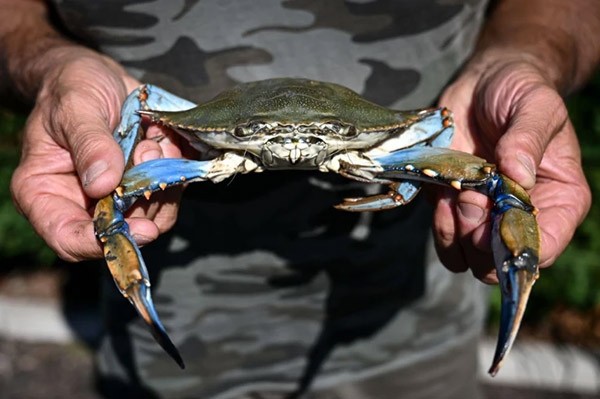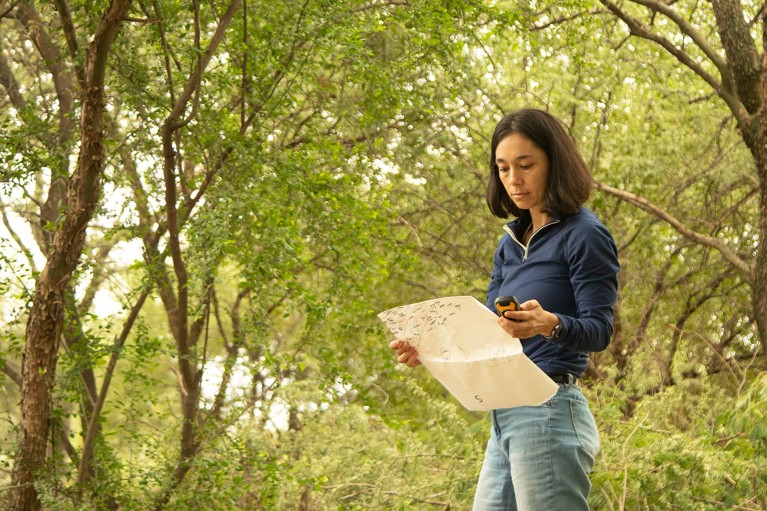Hello Nature readers, would you like to get this Briefing in your inbox free every day? Sign up here.

A fisher holds a blue crab in the lagoon of Scardovari, south of Venice. (Piero Cruciatti/AFP via Getty Images)
Blue crabs are invading Italian seas
Invasive Atlantic blue crabs (Callinectes Sapidus) are threatening Italy’s clam-farming and fishing industries. The Italian government has allocated nearly €3 million (US$3.2 million) to fund the capture of as many crabs as possible. It is unlikely that this will eradicate the species, which seems to spread in already-degraded ecosystems, but it could create a new industry. In 2015, a similar crisis in Tunisia left fishers with little in their nets but blue crabs and damaged fish that could not be sold, recalls biodiversity researcher Jamila Ben Souissi. Now the country has nearly 50 crab-processing plants. “At first fishers wanted this species to disappear, but now they are asking the authorities for regulations to protect it,” says Ben Souissi.
Dishonest ChatGPT use slips past reviewers
Scientific sleuths are spotting academic papers written with the undisclosed help of the artificial-intelligence chatbot ChatGPT. Most publishers allow authors to use such large language models (LLMs) — as long as the researchers are transparent about this usage. But papers with undeclared ChatGPT use are slipping through the peer-review process. Searches for common phrases such as ‘As an AI language model, I…’ pick up obvious examples, but the number of papers with undeclared ChatGPT content is probably much greater. “It’s only the tip of the iceberg,” says scientific sleuth Guillaume Cabanac.
Surprises from India’s Moon mission
During its two-week sojourn in the area around the Moon’s south pole, India’s Chandrayaan-3 mission has already provided remarkable insights. The lander’s seismograph recorded a suspected moonquake, and the rover unambiguously confirmed the presence of sulfur in the lunar surface. “Sulfur, being volatile, is not generally expected,” explains astrophysicist Anil Bhardwaj. Moreover, measurements of the Moon’s surface temperature find it to be significantly warmer than recorded by NASA’s 2009 Lunar Reconnaissance Orbiter, and “far too warm for water ice to be stable”, says planetary scientist Paul Hayne.
Indigenous-knowledge research hub
The US National Science Foundation (NSF) has launched its first research hub to unite Indigenous knowledge with Western science, allocating the hub US$30 million in funding over five years. The centre will attempt to set itself apart in how information is managed, disseminated and ultimately returned to Indigenous communities. “You share what you’ve learnt, and you do that through stories, through art, through any accessible means,” says Sonya Atalay, an archaeologist of Anishinaabe-Ojibwe heritage and co-leader of the centre. “It’s an integral part of the circle of doing science.”
Features & opinion
The extraordinary origins of the SDGs
The influential and ambitious United Nations Sustainable Development Goals (SDGs) were the brainchild of two unsung Colombian women: Paula Caballero and Patti Londoño. The two policymakers conceived the idea and persuaded the rest of the world to back it — and to let scientists design the goals free of political interference, as much as was practical. Nature’s Ehsan Masood reviews their recent memoir, along with that of Richard Jolly, whose long career as a development economist at the UN helped to inform the SDGs.
Why Juneteenth matters for science
In light of recent US court rulings on racism in science and affirmative action in higher education, biophysicist Antentor Hinton argues that Juneteenth matters more than ever for science. Juneteenth is an annual commemoration of the emancipation of enslaved African Americans in the United States. Hinton and 51 other Black scientists issued a call this year, in the journal Cell, for science to mark Juneteenth by reducing burdens on Black researchers and eradicating barriers to equitable science. Hinton pulls out some examples of actionable steps that scientists can take in preparation for the US holiday on 19 June.
Reference: Cell commentary
Where I work

Micaela Camino is the director of Project Quimilero in Colonia Benítez, ArgentinaCredit: Constanza Pasian for Nature
Ecologist Micaela Camino is studying a map of an area in the Argentinian Chaco Seco forest that was drawn with the help of elder Wichí members. “We meet with the Indigenous Wichí people to record places, animals and plants that are important to them,” she says, explaining her work as the director of Project Quimilero, which aims to protect pig-like peccaries (Catagonus wagneri). “We now understand that the Western concept of ‘territory’, with its rigid boundaries, doesn’t make sense to these communities,” Camino says. “Changes in seasons, soil-saturation levels and animal movements force these peoples to go beyond those boundaries to hunt and collect water.” (Nature | 3 min read)
